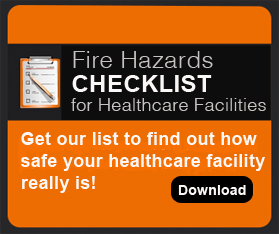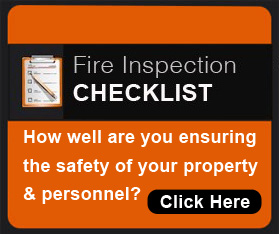In a hospital or healthcare environment─ including nursing homes─ the potential safety risks cast a wide net; everything from violence to infectious disease control. Fire safety is just one of the risks that medical facilities need to be ready for.
According to the National Fire Protection Association (NFPA), between 2006 and 2010, there were 6,240 fires on healthcare properties, almost 25% of which were in hospitals or hospices. Those fires resulted in six civilian deaths, 171 civilian injuries, and $52.1 million in direct property damage. Here in Toronto, Ontario, fires in healthcare facilities regularly make the news, most often related to nursing homes, but also sometimes for hospitals.

If you work in a healthcare facility, here is a list of some of the common fire hazards to watch out for. Run through the list and help your facility stay on the right side of fire and building code compliance.
2. Cluttered hallways. Do you have furniture and equipment in the hallways that would make it difficult to quickly evacuate bedridden and wheelchair bound patients?
3. Broken fire safety exit signs. Are yours burnt out? In a blackout, could your exits be seen?
4. Disabled and improperly used fire doors. Are yours propped open with equipment, wedged open with doorstops, or unable to close or latch properly? If so, they won’t offer protection in the event of a fire, costing you a precious 20 minutes when you need it the most.
5. Fire extinguishers. Are yours missing, inaccessible, previously discharged, improperly mounted, or past due for inspections? Do you have enough working fire extinguishers where you can get to them when you need them? Read
more about fire extinguishers here.
7. Gas Cylinders and Medical Oxygen Storage. The same equipment that saves lives is also a huge fire safety risk. Filled with flammable gas, take care not to store too many of these in proximity to mitigate the risk of a large explosion.
8. Hand Sanitizer. Just walking into a hospital may make you want to instinctively reach for the hand sanitizer. Chances are, you won’t have far to walk. Because alcohol-based hand sanitizer is highly flammable, be sure yours are not located near electrical outlets, light switches, or circuit boards. Also, do not store large quantities of hand sanitizer together, to reduce the fire risk.
9. Laboratory. If your facility includes a laboratory where flammable chemicals or pharmaceuticals are stored, ensure that special measures are taken there for fire safety. (Earlier this year, just such as fire
occurred at a hospital lab in California).
10. Extension Cords. Particularly in residential medical facilities, it’s common to see multiple extension cords and power strips “jerry-rigged” together, posing a huge electrical hazard. Be sure people are using electricity safely.
11. Small appliances and electronic gadgets. Increasingly, we hear of consumer electronic devices and appliances that are catching fire. Help remind people to unplug (and turn off, if applicable) when their devices are charged and not in use. Watch out for portable heaters that don’t have built in fire safety features such as automatic tip-over switches.
12. Laundry room. People are increasingly aware of the fire safety risks posed by unclean lint filters in their home dryers. So it should come as no surprise that 10% of healthcare facilities fires between 2006 and 2010 were initiated in laundry facilities, making it the second most likely cause of fire (according to the NFPA). Due to sanitation concerns, the laundry room at a medical facility is constant hub of activity. Laundry staff must be educated and vigilant about maintaining washers and dryers to avoid threats to fire safety.
13. Kitchen. Cooking equipment was responsible for 61% of healthcare facilities fires between 2006 and 2010, according to the NFPA─ by far the biggest cause of fire. Whether it’s a small kitchen or a commercial-grade operation, healthcare facilities’ kitchens should follow all fire safety protocols. Read more about
professional kitchen fire suppression systems here.
4 Tips to Be Ready for a Fire:
- Keep working and well-maintained fire safety equipment, including fire extinguishers, a fire sprinkler system, a fire alarm system and suppression system.
- Train your staff on fire extinguisher use, evacuation procedures, and other fire safety education. The regular staff training at the Fairview Lodge nursing home in Whitby (where an entire wing was recently destroyed by fire) is widely considered to have been the reason why the staff was able to safely evacuate 192 residents with no injuries.
If you need fire safety assistance in the Greater Toronto Area, call Rohen Fire today!




